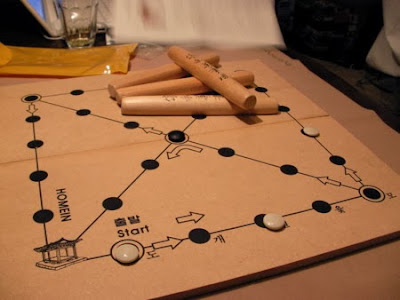Yutnori (윷놀이) is a traditional Korean board game that has been enjoyed for centuries, especially during festive occasions such as the Lunar New Year (Seollal). The game combines elements of strategy and chance and is often played by family members, friends, and neighbors. It symbolizes fun, unity, and community spirit.
Origins and History
The exact origins of Yutnori are unclear, but the game has deep roots in Korean history, believed to date back over a thousand years. It was initially played by farmers as a means to predict the upcoming year’s harvest or to determine fortune. Over time, it became a staple for holiday celebrations, representing hope and good fortune for the new year.
- Equipment and Setup
Yutnori requires a few basic components:
- The Yut sticks (윷, Yut): The game uses four wooden sticks, typically flat on one side and rounded on the other. These are thrown to determine how far the players' tokens can move on the board. Depending on how the sticks land (rounded or flat side up), different moves are made.
- The Board (말판, Malpan): The board is either drawn on paper, cloth, or wood. It features 29 positions forming a cross, with a path circling around the edges and diagonal shortcuts in the center. Players’ tokens travel around the board to complete a lap.
- Tokens (말, Mal): Each team has tokens, often represented by small markers like coins, pebbles, or figurines. Each team typically has four tokens that they try to move around the board based on their Yut throws.
- How to Play
Yutnori is played by two teams or individual players, and the goal is to move all four tokens around the board and back to the starting point before the other team.
Basic Steps:
Throwing the Yut Sticks: Players take turns throwing the four Yut sticks to determine how many spaces they can move. The outcome is based on how the sticks land:- Do (도): One flat, three round sides up – Move one space.
- Gae (개): Two flat, two round sides up – Move two spaces.
- Geol (걸): Three flat, one round side up – Move three spaces.
- Yut (윷): Four flat sides up – Move four spaces.
- Mo (모): Four round sides up – Move five spaces.
Moving Tokens: Depending on the result of the throw, players advance their token(s) on the board. If a player rolls a Yut or Mo, they get an extra turn.
Capturing and Teaming Up: If a player lands on a space occupied by an opponent's token, they can capture it, sending the opponent's token back to the start. If a player lands on their own token, they can "team up," moving multiple tokens together as one unit.
Winning the Game: The first team to move all their tokens around the board and back to the starting point wins.
- Strategy
Though the game is based largely on chance, strategy plays a significant role, especially in choosing when to split or group tokens, when to use shortcuts, and how to capture opponents. Some players may prioritize getting all tokens out on the board quickly, while others may focus on protecting grouped tokens for a faster lap.
- Cultural Significance
Yutnori is more than just a game; it has cultural and symbolic importance. It is traditionally played during Seollal (Lunar New Year) as a way to bring families together and strengthen bonds. The game reflects themes of luck, community, and familial cooperation. Additionally, it is sometimes believed that a family’s success in Yutnori could indicate good fortune for the year ahead.
- Modern Adaptations
In modern Korea, Yutnori is still widely played, especially during holidays and in rural areas. Many families have their own boards and sets of Yut sticks, and in some cases, the game has evolved with more elaborate boards or digital versions for younger generations. There are even annual Yutnori tournaments in certain communities.

Comments
Post a Comment